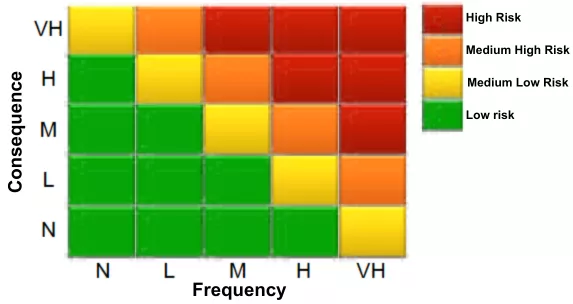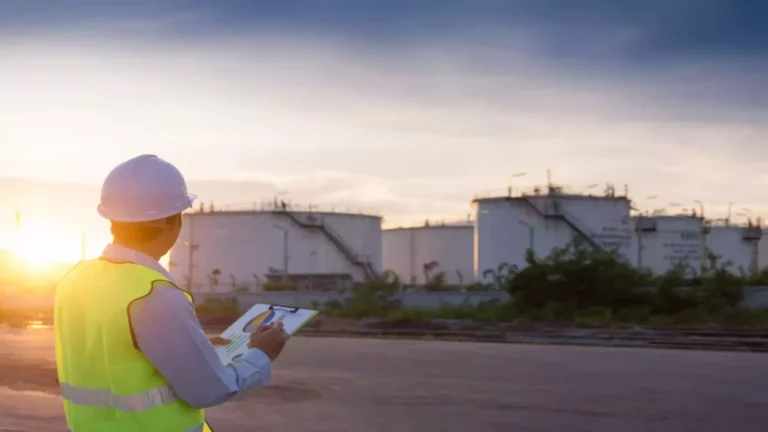Introduction
Conventional inspection methods for assessing the storage tank reliability are based on fixed intervals that are resource-intensive and insufficient for addressing the specific risks associated with these assets. These practices necessitate taking equipment offline for scheduled inspections, a reactive approach that fails to consider the actual necessity of such maintenance.
In response to these issues, Risk-Based Inspection (RBI) has emerged as a preferred method to enhance the storage tank reliability. Integrated with the API RP 580 standard, RBI allows for scheduling inspections based on actual risk assessment, thereby minimizing disruptions and optimizing both resources and operational safety.
This approach evaluates the Probability of Failure (PoF) and Consequence of Failure (CoF) to enhance inspection resource allocation, bolstering long-term reliability and safety of storage assets. This article will delve into the significance of the RBI methodology for risk-based inspection planning, a crucial tool for maintaining the reliability of these assets.
What is Risk-Based Inspection and what are its benefits?
Risk-Based Inspection (RBI) is a sophisticated methodological process that prioritizes inspection and maintenance activities by evaluating and integrating the probability of failure of equipment or installations with their potential consequences. It helps organizations focus their resources on higher-risk equipment, ensuring more efficient and targeted maintenance management.

The RBI approach centers on a comprehensive risk analysis that takes into account critical factors such as operational history, process conditions, design features, maintenance and inspection records, service time, and deterioration mechanisms, along with the potential consequences of a failure. This information is vital for determining the optimal frequency of inspections and the required maintenance type, as well as for selecting the appropriate and effective inspection techniques.
The API RP 580 standard, developed by the American Petroleum Institute, is essential for implementing Risk-Based Inspection (RBI). This standard provides guidelines for setting up inspection plans for fixed assets and planning inspections based on probabilistic characterization of deterioration and modeling the consequences of failures. It customizes inspection strategies to meet the specific needs of each piece of equipment, aligning maintenance practices with actual risk levels to avoid unnecessary interventions.
Implementing a RBI program offers numerous benefits, including increased reliability and availability of assets, reduced likelihood of catastrophic failures, extended operational periods, and future behavior modeling of equipment. Additionally, it optimizes resource utilization by reallocating efforts from lower-risk to higher-need areas, thereby enhancing the long-term reliability of storage assets.
Connection between API 653 and API RP 580 for Storage Tank Inspections
In recent updates to API 653, Risk-Based Inspection (RBI) has been integrated as a method for scheduling both initial and subsequent internal inspections of storage tanks. According to API 653, RBI involves a systematic risk analysis that combines the probability and consequences of failure as defined in API RP 580.
Practically, API RP 580 serves as a tool within the API 653 framework to determine when and how inspections should be conducted, thus extending beyond prescribed standard intervals. This approach allows organizations to effectively manage tank inspections in accordance with API RP 580 guidelines, enhancing the accuracy and safety of maintenance scheduling, and contributing to overall process improvement.
Storage tank integrity assessment with Risk-Based Inspection
Over time, operational processes and environmental conditions degrade the integrity of storage tanks, increasing the risk of failures that compromise their structure, functionality, and safety. Early identification of potential damage mechanisms such as internal and external corrosion, wall thinning, and deformations is crucial for assessing and mitigating associated risks, ensuring operational continuity.
The Risk-Based Inspection (RBI) methodology, guided by the API RP 580 standard, offers a framework for conducting detailed integrity evaluations of tanks through both qualitative and quantitative risk analysis. This approach moves beyond traditional fixed-interval maintenance methods, which may not accurately model deterioration rates, by considering the probability and consequence of failure beyond mere containment loss.
The mechanical integrity and proper functioning of a storage tank depend on its ability to operate safely and reliably under both standard and anomalous conditions. Maintenance approaches achieved through RBI ensure that tanks operate efficiently over time, highlighting the importance of mitigating and managing detected risks.
Effective implementation of RBI in storage tanks under API RP 580 Standard
Risk-Based Inspection (RBI) is a premier tool for managing the integrity of storage tanks, governed by the API RP 580 standard. This methodology identifies critical areas requiring attention to ensure safe operations and systematizes the process through several steps:
- Formation of a Multidisciplinary Team: Assembling a team with expertise in engineering, inspection, maintenance, corrosion, and risk management is essential.
- Scope and Objectives Definition: Define the specific objectives of the assessment, which tanks to include, and available resources.
- Scope and Objectives Definition: Define the specific objectives of the assessment, which tanks to include, and available resources.
- Probability and Consequence of Failure Evaluation: These analyses estimate the likelihood and consequences of failures, essential for assessing each equipment’s risk level.
- Probability and Consequence of Failure Evaluation: These analyses estimate the likelihood and consequences of failures, essential for assessing each equipment’s risk level.
- Risk Analysis and Tank Prioritization: Combining Probability of Failure (PoF) and Consequence of Failure (CoF) allows for ranking tanks by risk level and prioritizing those needing immediate attention.
- Development and Execution of a Detailed Inspection Plan: Specify frequencies, methods, and evaluation criteria for each tank, considering risk level analysis, predominant degradation mechanisms, and previous inspection history.
- Evaluation of Results and Data-Based Decision Making: Inspection results should be analyzed to identify maintenance needs and validate the inspection plan’s effectiveness.
Implementing an RBI system according to API RP 580 optimizes the safety and efficiency of storage tanks and ensures that all corrective actions are based on rigorous evaluation and reliable data, securing the long-term integrity of these assets.
Optimizing storage tank reliability through RBI
The perception of tank integrity is shifting from a condition-based to a risk-based approach. The extended internal inspection interval driven by Risk-Based Inspection (RBI) has become a key strategy for enhancing the operational reliability of storage tanks. Supported by API RP 580, this methodology allows maintenance managers to assess and manage equipment risks.
By incorporating detailed analyses probability and consequence of failure, RBI promotes the development of inspection and maintenance plans that enhance safety and reliability, reduce operational costs, and extend asset lifespan. This approach involves rigorous evaluation and specific control measures, ensuring safer and more efficient operations.
The contribution of robotics in Risk-Based Inspections
Robotics in risk-based storage tank inspections, when applied correctly, yield multiple benefits: they enable internal inspections without decommissioning tanks and remove personnel from unsafe conditions. First and second generation robots autonomously navigate and collect reliable Probability of Failure (PoF) and Consequence of Failure (CoF) data. This critical data enhances RBI evaluations by improving tank risk identification and prioritization.
The technology includes autonomous floating and submersible robots that perform detailed measurements like bottom thickness and annular plate checks using techniques such as Phased Array Ultrasonic Testing (PAUT) or Pulsed Eddy Current (PEC), along with high-definition video cameras for remote visual inspection, providing comprehensive coverage1.
The following video demonstrates an internal robotic inspection of a storage tank, showcasing how this technology assesses the internal conditions without significantly disrupting service. This method gathers critical data used in Risk-Based Inspections (RBI). Video provided by Square Robot.

Robotic innovation for inspecting Square Robot tanks.
This data analysis optimizes integrity programs by extending inspection and maintenance intervals for lower-risk tanks and focusing resources on higher-risk ones, thereby reducing costs and enhancing overall system reliability.
Conclusions
Risk-Based Inspection (RBI), supported by API RP 580 and associated with API 653, significantly enhances the storage tanks reliability by incorporating advanced methodologies that evaluate and manage deterioration risks like corrosion. This systematic application assesses failure probability and consequences, optimizing resource allocation and inspection intervals to extend asset lifespan.
The integration of first and second generation robotic inspections with customized tools such as Phased Array Ultrasonic Testing (PAUT) and Pulsed Eddy Current (PEC) facilitates the implementation of non-intrusive, risk-based inspection and maintenance plans, in line with these standards.
References
- https://becht.com/becht-blog/entry/robotics-and-risk-based-inspection-assessments-tools-supporting-storage-tanks-integrity-management-optimization/.
- https://www.api.org/products-and-services/individual-certification-programs/certifications/api580


























